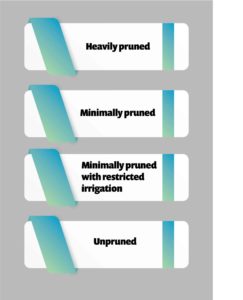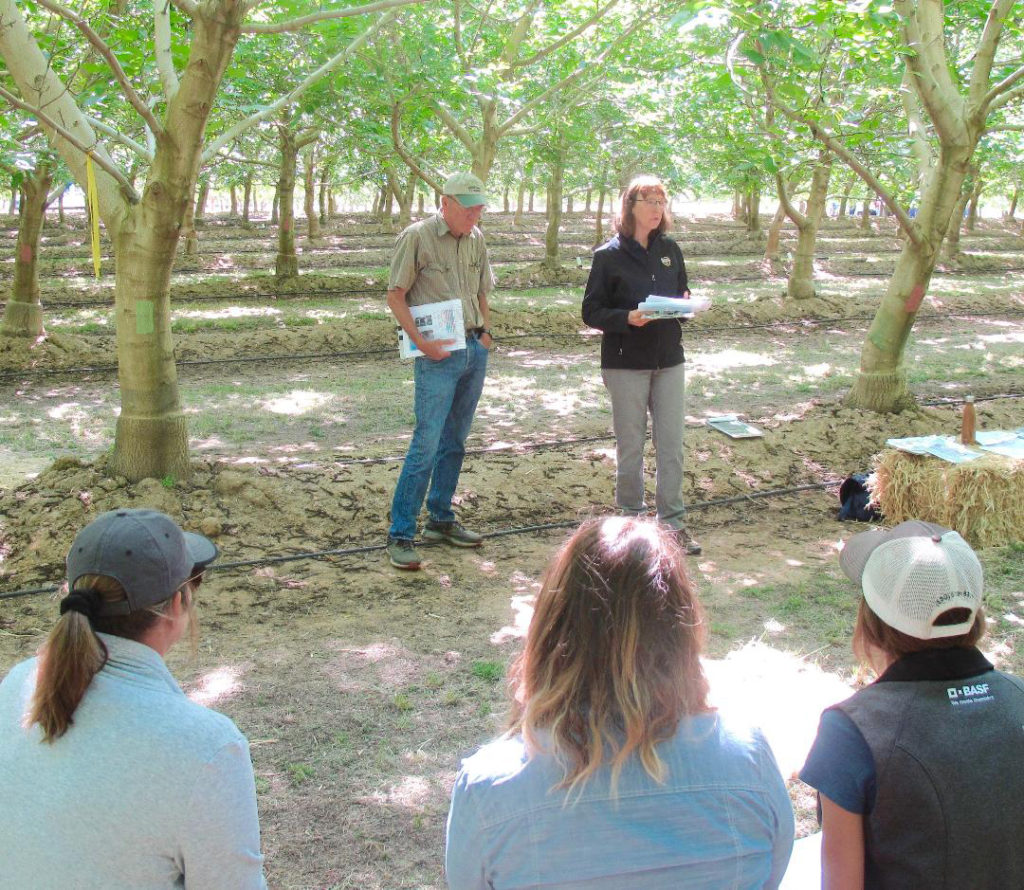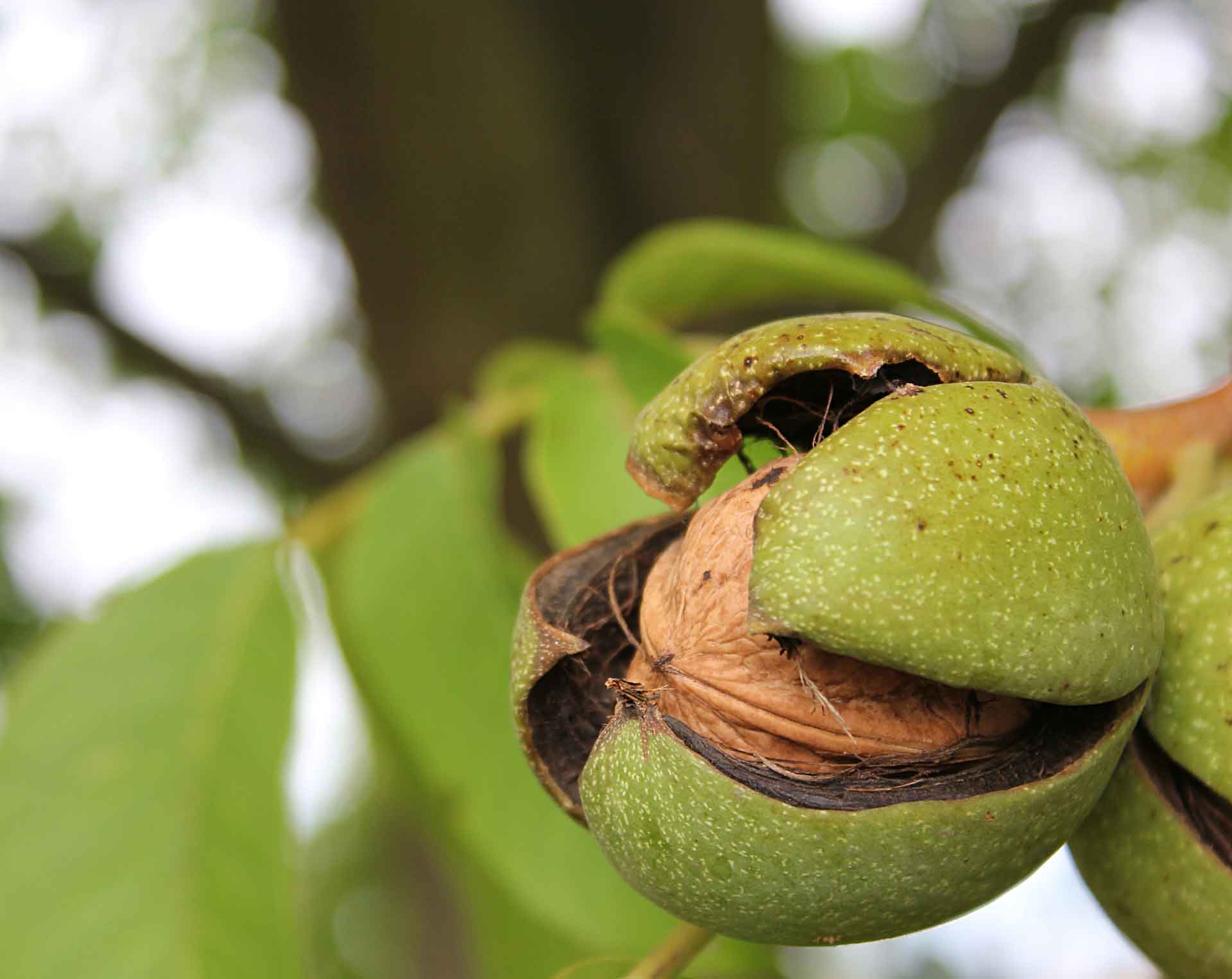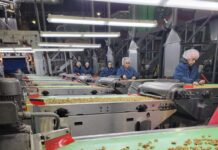A Chandler walnut hedging and whisking trial on an 11-year-old Chandler block was the topic of discussion for presenters Bruce Lampinen, integrated orchard management and walnut specialist, University of California (UC) Davis, and Janine Hasey, University of California Cooperative Extension (UCCE) farm advisor and walnut specialist, at the 42nd Annual Nickels Soil Lab Field Day in Arbuckle.
Hedgerow walnut planting, like all agricultural practices, has its proponents and opponents, its pros and cons. It was those pros and cons the research team shared with those attending the field day. The hedgerow practice in walnut orchard planting is a high density system believed to reduce pruning costs and to benefit early production. However, the system also has its drawbacks as explained by Hasey and Lampinen.
In this trial, the trees were planted in March 2008 on a one foot berm, at a spacing of 15 x 22 feet (32 trees per acre). The trees were nursery budded on Paradox rootstock. The orchard is irrigated with double line drip with inline emitters spaced 22 inches apart.
Because of the tight spacing of this trial, overcrowding has become a major issue, according to Lampinen.
A mechanical hedging trial has been overlaid on the western most rows of the trial with six replications of three different years of hedging. On the eastern four rows, there are plans for a whisking trial imposed with four replications of every other tree being whisked back to allow better light penetration and reduce shading related issues. The option to remove every other tree which was whisked will be evaluated after several years, according to the research duo. The trial is also being used to investigate the role of pruning/hedging cuts on Botryosphaeria in walnut.
Pruning/Less Pruning
To start off, Hasey and Lampinen talked about a previous multi-year trial they conducted in the same hedgerow orchard.
“I was skeptical about this study originally,” now-retired Hasey says. “The data makes a compelling case that we need to re-evaluate years of pruning practices.”
This trial looked at ways to improve pruning methods to gain a better tree structure, improve the amount of fruit wood, decrease wind damage and potentially reduce the need for early hedging of the orchard.
The objective of the trial was to consider different training styles in the early years for hedgerow planted Chandler walnuts. The trial also conducted a cursory evaluation of two new varieties, Gillet and Forde, and compares them to the older varieties of Tulare and Chandler for their ability to be trained in a hedgerow planting.
A secondary goal of this experiment was to see if reducing vigor with deficit irrigation in the third-eighth year would postpone the need for early hedging and help maintain a smaller sized tree without negative impacts on yield.
Four training systems were implemented starting in 2009 after the first season of growth:
• Heavily pruned
• Minimally pruned
• Minimally pruned with restricted irrigation
• Unpruned
Tree growth characteristics of diameter, height, canopy size (light interception), and yield were measured in 2009-2015. Plant water status was measured using midday stem water potential throughout the growing season.
The 2015 Chandler results showed a difference in average circumference and height, with the heavily pruned treatment being significantly smaller and shorter than the minimally pruned treatment and the untrained/unpruned treatment but no significant difference in photosynthetically active radiation (PAR) interception, yield, cumulative yield, or yield per unit PAR intercepted among treatments.
By the end of the study, the unpruned and minimal pruned treatments were significantly larger in trunk circumference compared to the heavily pruned treatment. These results also showed unpruned treatments tending to produce higher yields in the early years and cumulative treatment differences becoming non-significant by the fifth year.
According to Hasey and Lampinen, the study continues to suggest that walnut trees can be grown with minimal or no pruning in years one to six without detrimental effects on tree size, yield or quality.
Canopy Management
Lampinen said orchards that are planted in a hedgerow configuration eventually require some type of canopy management to allow safe machinery access down the drive row. In addition, potential yield is limited by the percentage of the total incoming light that a canopy can intercept. The orchard age when canopy management needs to take place varies depending on tree spacing, variety, orchard vigor, and rootstock.
The objective of the current study was to test different methods of managing a mature hedgerow Chandler planting.

In the whisking trial, orchard management didn’t actually remove any trees but whisked every other tree to allow more light into the orchard, Lampinen said.
“It didn’t do a whole lot of good for us because the trees grew back very rapidly,” he added. “When we did the whisking in September, the trees had already grown back to the same amount of shade before the whisking could serve any positive purpose.”
Lampinen said the trees in the trial orchard were planted at a much too high density. “This eventually becomes very problematic,” he added. “The crop growth continues to move up in the tree and it gets to the point where you can’t get any spray coverage.”
The teams concluded that the trial didn’t implement severe enough cuts in the hedgerow pruning to impact the light interception.
“I’ve never been a big fan of hedging,” Lampinen said. “Basically, this trial confirmed what I already thought; you have to cut the trees so severely to have any significant effect on the light interception that you really cut the crop back and there is no benefit in that results.”
Botryosphaeria
Botryosphaeria (Bot) infection requires susceptible tissue, dampness, and a lack of light. All of these conditions were found in the hedgerow trial orchard, said Hasey, resulting in a higher than expected infection from the pathogen.
The density of hedgerow planting results in a higher amount of light interception into the orchard and orchard floor, creating an atmosphere conducive to retaining moisture. In addition, the higher amount of wounds created by whisking or hedging produces a vast number of susceptible points of entry for Bot.
The pathogen produces abundant water-splashed pycnidiospores and wind-borne ascospores. Practically-speaking, this means Bot can spread by spores dripping and splashing or by blowing around in the orchard. The density of hedgerow planting provides conditions for the easy spread of the spores and in a variety of venues, be it pruning wounds, and the pruning methods often used in those orchards.
Bot damage reduces yields by killing small fruit wood and large branches and directly infecting the nut.
As with any walnut orchard, Hasey says two of the ways to fight Bot is with cultural and chemical control. With hedgerow plantings, the need to control light interception is another key component, but one difficult to control, as Lampinen described.
Like Lampinen, Hasey said she is not a proponent of hedgerow planting in walnuts as the benefits of earlier and larger crops in the first seven years do not outweigh the difficulties the practice creates in most every other area of orchard management.











